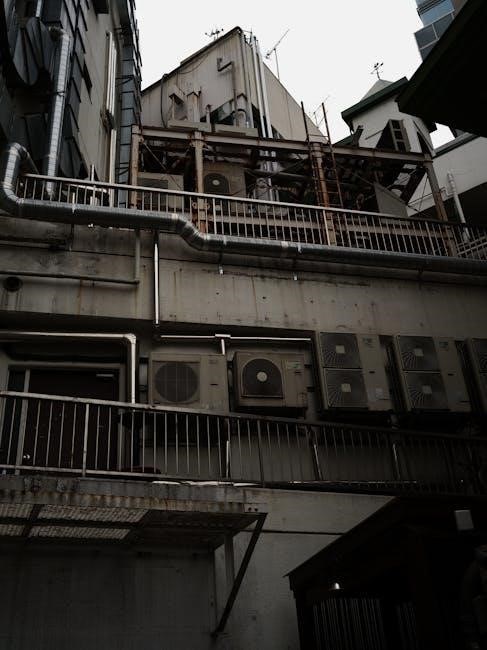Understanding HVAC terms and definitions is crucial for professionals and homeowners alike. Downloadable PDF guides provide comprehensive glossaries, ensuring clarity in system design and troubleshooting. These resources empower informed decisions and optimal system performance, making HVAC terminology accessible to all.
What is HVAC?
HVAC stands for Heating, Ventilation, and Air Conditioning. It refers to systems designed to control indoor climate, ensuring comfort and air quality. HVAC encompasses heating (via furnaces or boilers), ventilation (air circulation and purification), and cooling (through AC or heat pumps). These systems regulate temperature, humidity, and airflow to maintain a healthy and comfortable environment. Understanding HVAC terminology is essential for professionals and homeowners to discuss, install, and maintain these systems effectively. Resources like PDF guides provide detailed explanations, helping users master the fundamentals of HVAC technology.
Importance of Understanding HVAC Terminology
Understanding HVAC terminology is vital for effective communication between professionals and homeowners. Clear definitions enable accurate discussions about system design, troubleshooting, and maintenance. With resources like downloadable PDF guides and comprehensive glossaries, mastering HVAC terminology becomes accessible. This knowledge empowers professionals and homeowners to make informed choices and optimize system performance. Accurate terminology ensures precision in problem-solving and enhances collaboration, leading to better outcomes in installations, repairs, and energy efficiency. It bridges the gap between technical complexity and practical application, fostering a deeper understanding of HVAC systems.
Common Resources for HVAC Definitions (e.g., PDF Guides)
Various resources are available to help understand HVAC terminology. Downloadable PDF guides provide comprehensive glossaries and detailed explanations. For instance, the REHVA publications offer definitions of commonly used terms, while Robert C. Rosaler’s guide covers technical aspects like the refrigeration cycle and psychometrics. These resources are invaluable for professionals and homeowners, offering clear and concise information. They ensure accurate communication and informed decision-making, making complex HVAC concepts more accessible.

Key HVAC Concepts
HVAC systems involve heating, ventilation, and air conditioning. Essential components include thermostats for temperature control, ductwork for air distribution, and heat pumps for efficient heating and cooling.
Heating, Ventilation, and Air Conditioning (HVAC) Systems
HVAC systems are designed to provide thermal comfort, air quality, and humidity control in indoor spaces. They integrate heating, ventilation, and air conditioning functions. These systems use components like ductwork, thermostats, and heat pumps to regulate temperature and airflow; Proper installation and maintenance ensure energy efficiency and optimal performance. Understanding HVAC terminology is essential for professionals and homeowners to make informed decisions about system design, troubleshooting, and maintenance.
Thermostat: Definition and Function
A thermostat is a device that regulates temperature by controlling HVAC system operations. It maintains desired indoor temperatures by monitoring and adjusting heating and cooling outputs. Modern thermostats, including smart thermostats, offer programmable settings and remote access for enhanced energy efficiency. Proper installation and calibration ensure accurate temperature control, optimizing system performance and reducing energy consumption. Thermostats are essential for achieving comfort and efficiency in residential and commercial settings.
Ductwork: Role in HVAC Systems
Ductwork is a network of tubes that distributes heated or cooled air throughout a building. It connects HVAC equipment to vents, ensuring consistent air circulation. Properly insulated and sealed ducts minimize energy loss, improving system efficiency. Regular maintenance, including cleaning and sealing, prevents leaks and contamination, ensuring optimal performance. Ductwork is crucial for maintaining indoor air quality and comfort, making it a vital component of HVAC systems. Effective duct design and installation enhance overall system functionality and energy savings.
Heat Pump: Purpose and Operation
A heat pump is a device that transfers heat from one location to another, providing both heating and cooling. It operates by circulating refrigerant through a cycle of evaporation and condensation. In heating mode, it extracts thermal energy from outdoor air or ground and transfers it indoors. In cooling mode, it removes heat from indoors and releases it outside. Heat pumps are highly efficient, especially in moderate climates, and are often used in split systems and package units for space heating and cooling. Their versatility makes them a key component in modern HVAC systems.

Core HVAC Equipment
Core HVAC equipment includes furnaces, boilers, condensing units, and evaporator coils. These components are essential for heating, cooling, and air conditioning systems, ensuring efficient climate control and comfort.
Furnace: Definition and Types
A furnace is a key HVAC component that generates heat using fuel sources like natural gas, propane, or electricity. It circulates warm air through ductwork, ensuring indoor comfort. Types include gas furnaces, known for efficiency, and electric furnaces, which are cost-effective. High-efficiency furnaces often feature condensing technology to maximize energy use and reduce operational costs. Proper maintenance and installation are crucial for optimal performance and safety, making furnaces a reliable choice for heating systems.
Boiler: Function and Applications
A boiler is an essential HVAC component that heats water or produces steam for heating systems. It operates by burning fuel, such as natural gas, propane, or oil, to generate heat. Boilers are commonly used in hydronic systems, where heated water is circulated through radiators or underfloor pipes. They are highly efficient and durable, making them ideal for residential and commercial applications. Boilers also provide hot water for domestic use and are known for their quiet operation and long lifespan compared to other heating systems.
Condensing Unit: Outdoor Component of HVAC Systems
The condensing unit is a critical outdoor component of HVAC systems, typically part of split systems. It houses the compressor, condenser coil, and fan. Its primary function is to release heat from the refrigerant into the outdoor air, enabling the cooling process. Proper placement and maintenance of the condensing unit are essential for efficient operation and overall system performance. It plays a vital role in both heating and cooling by facilitating heat transfer between the indoor and outdoor environments, ensuring optimal energy efficiency and system reliability.
Evaporator Coil: Role in Cooling
The evaporator coil is a key component in HVAC systems, primarily responsible for cooling the air. It absorbs heat from the indoor air as the refrigerant flows through it, causing the liquid refrigerant to evaporate into a gas. This process cools the surrounding air, which is then circulated throughout the building. Proper maintenance, such as cleaning and ensuring adequate airflow, is essential for optimal performance. The evaporator coil works in conjunction with the condensing unit to complete the refrigeration cycle, making it indispensable for effective cooling in HVAC systems.

HVAC Components
Key HVAC components include refrigerant, compressor, capacitor, and expansion valve. These elements work together to facilitate heating, cooling, and air circulation. Detailed explanations are available in HVAC PDF guides.
Refrigerant: Types and Importance
Refrigerants are substances used in HVAC systems to transfer heat during cooling cycles. Common types include chlorofluorocarbons (CFCs), hydrochlorofluorocarbons (HCFCs), and hydrofluorocarbons (HFCs). Each has unique properties and environmental impacts. CFCs, for instance, are being phased out due to ozone depletion concerns. HFCs are more eco-friendly but still contribute to global warming. Proper handling and selection of refrigerants are critical for system efficiency and environmental sustainability. HVAC PDF guides provide detailed information on refrigerant types, safety, and best practices for technicians and users.
Compressor: Key Component in HVAC Systems
The compressor is a vital part of HVAC systems, responsible for compressing refrigerant to facilitate heat transfer. It plays a central role in the refrigeration cycle, ensuring efficient cooling and heating. Different types of compressors, such as reciprocating, scroll, and rotary, are used depending on system size and application. Proper maintenance and operation of the compressor are essential for optimal system performance and energy efficiency. HVAC PDF guides offer detailed insights into compressor functionality, troubleshooting, and repair techniques for both professionals and DIY enthusiasts.
Capacitor: Function in HVAC Equipment
The capacitor is a critical component in HVAC systems, primarily responsible for storing and releasing electrical energy. It ensures the proper startup and operation of motors, such as compressors and fans, by providing the necessary power surge. Capacitors also help regulate voltage fluctuations, maintaining efficient system performance. There are two main types: start capacitors, which assist in motor startup, and run capacitors, which support continuous operation. Regular maintenance and replacement of faulty capacitors are essential to prevent system malfunctions. HVAC PDF guides provide detailed explanations and troubleshooting tips for capacitor-related issues.
Expansion Valve: Purpose and Operation
The expansion valve is a critical component in HVAC systems, responsible for reducing the pressure of refrigerant before it enters the evaporator coil. This reduction allows the refrigerant to expand and cool, enabling effective heat absorption from the surrounding air. The valve regulates refrigerant flow, ensuring optimal system performance and efficiency. There are two main types: thermal expansion valves (TXV) and fixed orifice expansion valves. Proper operation of the expansion valve is essential for maintaining desired temperatures and preventing system malfunctions. HVAC PDF guides provide detailed insights into its function and troubleshooting.

HVAC System Types
HVAC systems vary, including split systems with outdoor and indoor units, package units offering all-in-one solutions, and mini-split systems providing flexible, ductless heating and cooling options.
Split Systems: Outdoor and Indoor Units
Split systems are popular HVAC configurations, typically consisting of an outdoor condensing unit and an indoor evaporator unit. These systems are known for their efficiency and versatility. The outdoor unit houses the compressor and condenser, while the indoor unit contains the evaporator coil and fan. This setup allows for precise temperature control and reduced noise levels. Split systems are often used in smaller spaces or zoning applications, offering a flexible solution for heating and cooling needs. They are also relatively easy to install compared to traditional systems.
Package Units: All-in-One HVAC Solutions
Package units are self-contained HVAC systems that combine heating, ventilation, and air conditioning into a single unit. These all-in-one solutions are ideal for commercial and industrial spaces. They eliminate the need for separate components, simplifying installation and maintenance. Package units are typically placed outdoors and connected to ductwork, providing efficient climate control. Their compact design and integrated features make them a practical choice for buildings with limited space, offering both heating and cooling capabilities in one streamlined package.
Mini-Split Systems: Flexible Cooling and Heating
Mini-split systems are ductless HVAC solutions offering flexible cooling and heating. They consist of an outdoor compressor unit and one or more indoor units connected by refrigerant lines. These systems provide precise temperature control in specific zones, enhancing energy efficiency. Ideal for spaces without ductwork, mini-splits are quiet, compact, and easy to install. They are perfect for room additions, older homes, or areas requiring targeted climate control. Their sleek design and versatility make them a popular choice for modern heating and cooling needs, ensuring comfort without compromising aesthetics.

HVAC Performance and Efficiency
HVAC performance and efficiency are measured by ratings like SEER and AFUE. These metrics help determine energy consumption and system effectiveness, guiding optimal equipment selection and operation.
SEER (Seasonal Energy Efficiency Ratio)
SEER measures cooling efficiency over a season. Higher SEER indicates better energy use; It compares cooling output to energy consumed, helping consumers choose efficient systems and lower costs. PDF guides explain SEER’s importance in HVAC performance, guiding informed decisions for optimal energy savings and system effectiveness.
AFUE (Annual Fuel Utilization Efficiency)
AFUE measures heating efficiency, indicating the percentage of fuel converted to usable heat. Higher AFUE means lower energy waste. PDF guides detail AFUE’s role in evaluating furnace performance, helping users optimize heating systems for energy savings and environmental impact. Understanding AFUE aids in selecting efficient HVAC equipment, aligning with energy conservation goals and cost reduction.
Energy Efficiency Ratings: Understanding Importance
Energy efficiency ratings are vital for evaluating HVAC system performance. These ratings, often explained in PDF guides, help users compare equipment and make informed decisions. Higher ratings indicate better efficiency, leading to lower energy costs and reduced environmental impact. Understanding these ratings ensures optimal system selection, aligning with both economic and ecological goals. They are a cornerstone in modern HVAC practices, guiding consumers toward sustainable and cost-effective solutions.

HVAC Industry Standards
ASHRAE standards provide guidelines for HVAC system design and operation, ensuring efficiency and safety. IECC focuses on energy conservation, while NATE certification validates technician expertise, upholding industry quality.
ASHRAE Standards: Guidelines for HVAC Systems
ASHRAE standards are essential guidelines for designing, installing, and maintaining HVAC systems. They focus on energy efficiency, indoor air quality, and thermal comfort, ensuring safe and sustainable practices. These standards are widely adopted across the industry, helping professionals comply with regulatory requirements and optimize system performance. By adhering to ASHRAE standards, HVAC systems can achieve higher efficiency and reliability, reducing environmental impact while improving occupant satisfaction. These guidelines are regularly updated to reflect advancements in technology and evolving industry needs.
IECC (International Energy Conservation Code)
The IECC sets minimum energy efficiency requirements for building design and construction. It addresses HVAC systems, lighting, and insulation, ensuring energy conservation while maintaining comfort. Regular updates reflect advancements in technology and industry practices. Compliance with IECC standards helps reduce energy consumption, lower emissions, and promote sustainable building practices. The code provides clear guidelines for HVAC equipment efficiency, duct sealing, and insulation levels, balancing energy savings with cost-effectiveness. It is a critical resource for architects, engineers, and contractors aiming to meet modern energy efficiency goals.
NATE Certification: Technician Competency
NATE certification is a recognized standard for HVAC technician competency. It ensures professionals have the knowledge and skills to install, maintain, and repair HVAC systems effectively. The certification covers key areas such as heating, cooling, and air quality. Technicians must pass rigorous exams to demonstrate their expertise. This certification enhances credibility and trust with clients, ensuring high-quality service. It also promotes ongoing education, keeping technicians updated on the latest technologies and industry standards, which is essential for optimal system performance and energy efficiency.

Common HVAC Terminology
Downloadable PDF guides explain essential HVAC terms like BTU, airflow, and psychrometrics; These resources provide clear definitions and abbreviations, helping users understand complex concepts and improve system interactions.
Air Flow: Measurement and Importance
Air flow refers to the movement of air within HVAC systems, measured in cubic feet per minute (CFM). Proper air flow ensures efficient heating, cooling, and ventilation. Incorrect air flow can lead to reduced system performance and higher energy costs. Understanding air flow is critical for maintaining indoor air quality and thermal comfort. Resources like PDF guides provide detailed explanations of air flow measurement and its significance in HVAC operations, helping professionals optimize system design and troubleshooting.
BTU (British Thermal Unit): Definition and Use
BTU (British Thermal Unit) measures energy, specifically the amount needed to raise one pound of water by one degree Fahrenheit. In HVAC, BTU quantifies heating or cooling capacity. Higher BTU means greater energy output. Proper sizing ensures efficient heating and cooling, avoiding inadequate performance or energy waste. Understanding BTU is essential for selecting the right HVAC equipment. Resources like PDF guides provide detailed explanations, helping professionals and homeowners optimize system performance and energy efficiency.
Psychrometrics: Study of Air Properties
Psychrometrics is the study of air properties, including temperature, humidity, and enthalpy. It is vital in HVAC for designing systems that maintain indoor air quality and comfort; Psychrometric charts visualize these properties, aiding in the calculation of cooling and heating loads. Understanding psychrometrics ensures efficient system operation and optimal indoor environmental conditions. Resources like PDF guides offer detailed explanations, making it easier for professionals to apply psychrometric principles in real-world applications, enhancing system performance and energy efficiency.

HVAC Maintenance and Troubleshooting
Regular HVAC maintenance ensures system efficiency and longevity. Troubleshooting common issues, like faulty thermostats or clogged filters, prevents costly repairs. PDF guides offer detailed diagnostic tips, helping professionals and homeowners identify and resolve problems effectively, maintaining optimal performance and indoor comfort.
Filter: Types and Maintenance
Filters are essential for maintaining indoor air quality and HVAC system efficiency. Common types include fiberglass, pleated, HEPA, and activated carbon filters, each offering varying levels of air purification. Regular maintenance involves replacing filters every 1-3 months and cleaning reusable ones. Proper filter upkeep improves airflow, reduces energy consumption, and prevents system damage. Referencing HVAC terms and definitions PDF guides ensures understanding of filter specifications and maintenance schedules, optimizing system performance and indoor comfort.
Drainage: Importance in HVAC Systems
Drainage plays a critical role in HVAC system functionality and longevity. Proper drainage prevents water accumulation, which can lead to mold growth, structural damage, and system inefficiency. Condensate drains are essential for removing moisture produced during cooling processes. Clogged drains can cause backups, reducing performance and increasing energy costs. Regular inspection and maintenance of drainage systems are vital to ensure optimal operation. HVAC terms and definitions PDF guides provide detailed insights into drainage components and best practices, helping technicians and homeowners avoid common issues and maintain system integrity.
Troubleshooting Common HVAC Issues
Troubleshooting HVAC issues requires a systematic approach to identify and resolve problems efficiently. Common issues include uneven heating, cooling, or insufficient airflow. Understanding HVAC terms and definitions is key to diagnosing system malfunctions. Resources like HVAC terms and definitions PDF guides offer detailed explanations and solutions. They cover topics such as thermostat calibration, duct leaks, and refrigerant levels. Regular maintenance, as outlined in these guides, can prevent many issues, ensuring optimal performance and energy efficiency. Addressing problems promptly avoids costly repairs and extends system lifespan.
Advanced HVAC Technologies
Smart thermostats enable modern temperature control, while variable-speed systems optimize energy efficiency. Zoning systems provide customized heating and cooling, enhancing comfort and reducing energy consumption effectively.
Smart Thermostats: Modern Temperature Control
Smart thermostats revolutionize temperature management by learning user preferences and adapting to routines. They offer remote access via smartphones, geofencing, and energy usage reports. These devices integrate with home automation systems, optimizing comfort and efficiency. Advanced features like voice control and smart sensors ensure precise temperature regulation; By reducing energy waste, smart thermostats lower utility bills and environmental impact. They are a cornerstone of modern HVAC innovation, enhancing user experience while promoting energy conservation. Their functionality is detailed in various HVAC terms and definitions PDF guides, making them accessible to all users.
Variable-Speed Systems: Energy Efficiency
Variable-speed HVAC systems adjust fan and compressor speeds to meet precise cooling or heating needs. This modulation enhances efficiency, reducing energy consumption by avoiding constant on/off cycles. They operate quietly and maintain consistent temperatures, improving comfort. Detailed in HVAC terms and definitions PDF guides, these systems lower utility bills and environmental impact. Their adaptability ensures optimal performance across varying conditions, making them a preferred choice for modern energy-conscious solutions. This technology is a key advancement in achieving higher energy efficiency ratings in HVAC applications.
Zoning Systems: Customized Heating and Cooling
Zoning systems divide a building into independent areas with unique temperature controls. This allows for customized heating and cooling, enhancing comfort and energy efficiency. By using thermostats and dampers, zoning systems regulate air flow to specific zones, reducing waste. They are ideal for homes or offices with varying temperature needs. Detailed in HVAC terms and definitions PDF guides, zoning systems offer precise control, lowering energy bills and improving system performance. This advanced technology ensures tailored indoor climate solutions, adapting to diverse spatial requirements.

Glossary of HVAC Terms
A glossary of HVAC terms provides clear definitions of essential terminology and acronyms. These resources, often available as PDF guides, ensure accurate communication and understanding.
Absorbent: Role in HVAC Systems
An absorbent is a substance used in HVAC systems to absorb moisture or other substances. It plays a critical role in maintaining air quality and system efficiency. Commonly used in filters and dehumidification processes, absorbents prevent mold growth and corrosion. They are essential for controlling humidity levels, ensuring optimal indoor air quality, and protecting system components from damage caused by excess moisture. Proper use of absorbents enhances overall system performance and longevity, making them a vital component in HVAC operations.
Diffusers: Function in Air Distribution
Diffusers are devices installed in walls, floors, or ceilings to distribute air evenly throughout a space. They ensure consistent airflow, maintaining indoor air quality and comfort. By directing air in various patterns, diffusers prevent hot or cold spots, promoting uniform temperature distribution. Properly designed diffusers enhance system efficiency, reduce noise, and improve overall HVAC performance, making them essential for effective air distribution in residential and commercial settings.
Non-Condensable Gases: Impact on HVAC Performance
Non-condensable gases, such as air, nitrogen, and oxygen, can significantly affect HVAC system efficiency. These gases do not condense under normal operating conditions, leading to increased pressure and reduced coil performance. They can cause system inefficiencies, higher energy costs, and potential equipment damage. Regular maintenance, proper system design, and gas management strategies are essential to mitigate their impact and ensure optimal HVAC performance and longevity.
